|
< Earlier Kibitzing · PAGE 3 OF 3 ·
Later Kibitzing> |
| Sep-17-09 | | CHESSTTCAMPS: Black has the two bishops and is up a meaningless (doubled) pawn, but white has the full force of three major pieces and two minor pieces directed at the black kingside, defended directly only by the black queen. The Ra6 is screened off from defense of the kingside. It seems that white should be able to force a breakthrough on the f-file, where the battering ram of majors is lined up, but black is positioned to set up a deadly battery of his own by striking at e3 if the Nf5 leaves its post. A move that cames to attention quickly is: 23.Nh6+!!
The advocates for examining forcing moves first (the software design approach that makes chess engines so powerful) will love this solution. A) 23...gxh6 24.Rxf6 Rxe3
Now 25.Rxf7?? loses badly to Rxf3+, so I started to look at alternatives to 23.Nh6+, a serious flaw in my analytical approach. (Consult with <agb2002> on the benefits of self-flagellation.) However, a simple alternative does the job nicely: 25.Rg6+! hxg6 (Qxg6 26.Qf8#) 26.Qxf7#
A.1) 24... Qg7 25.Qxd5+ Be6 26.Rxe6 Bxe6 27.Qxe6+ Kh8 28.Rf8# A.1.1) 26...Qxc3 27.Re8+ forces mate quickly.
A.2) 24... Qe7! 25.Qxd5+ Be6 26.Qe4! (a hard move to find IMO - the threat is Rg6+) Bf7 27.Qg4+ Bg6 (Kf8 28.Qg7#) 28.Rxg6+ forces mate. A.2.1) 25... Qe6 26.Rxe6 Bxe6 27.Qf3 (not 27.Qh5 Bf7 28.Qh6?? Bxe3+) is clearly winning with Q+2Ps for B+R and a threat of Qf6. A.2.2) 26... d5 27.Rg6+ hxg6 28.Qxg6+ Qg7 29.Qxg7#
A.2.3) 26... Bxe3+ 27.Qxe3 (Kh1? Bf7 28.Qg4+ Bg5) d5 28.Qxh6 Bf7 (to prevent Rf8+) 29.Qg5+ Bg6 30.Qxd5+ Bf7 31.Qxf7+ wins A.3) 24... Bxe3+ 25.Qxe3 Rxe3 (Qxf6 26.Qxe8+) 26.Rxf7 Re8 27.Rxg7+ Kh8 28.Re7+ Kg8 29.Rxe8# B) 23... Kf8 24.Nxf7 Rxe3 25.d4 Rxf3 26.R1xf3 leaves white a rook up with a quick win. Nice problem with plenty of detail to work through - time to check. |
|
| Sep-17-09 | | njchess: Having studied Leonid Stein's games, I am familiar with this position. He was a very creative player who passed away just as his career was really beginning to take shape. Black makes an obvious error with 7. ... a5?; a gift that Stein hardly needs but gladly accepts. And by move 15, White has a decided advantage. Stein finishes nicely with the sacrificial 23. Nh6+ followed by the subtle, but powerful 26. Qe4. |
|
Sep-17-09
 | | gawain: The key is seeing how 26 Qe4 (or 26 Qh5) turns Rg6+ into an unanswerable threat. I did not see it. Therefore although I would have played 23 Nh6+ on spec I would probably not have figured out how to follow through. |
|
| Sep-17-09 | | kevin86: White's attack was as subtle as a Sherman tank. |
|
Sep-17-09
 | | Jimfromprovidence: 22...h5 would have been a good response instead of the blunder 22...d6.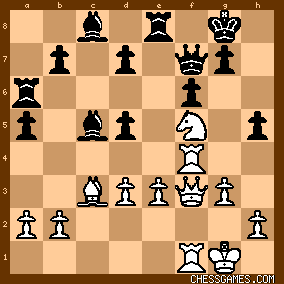
click for larger view It stops 23 Nh6 because the follow-up 24 Rxf6 now can't be played. It also prevents the rook from going to g4. Nevertheless, it's still an extremely dynamic position. |
|
| Sep-17-09 | | soprano: 23. Nh6 is obvious, without regard for what may happen on e3. White should by no means close the diagonal for his c3 bishop with Pd4 which is required for the attack while Black's activity on e3 is harmless. After 23...gh, 24. Rxf6 and the game is as good as over. No time for 23. Rxe3 and Bxe3 is harmless. Time to check. |
|
| Sep-17-09 | | TheChessGuy: One from Stein's streak of three USSR Championships in four years. The only interruption came in 1964, when Viktor Korchnoi won in Kiev with +11-0=8 for 15/19, clear first by two points over David Bronstein. Stein got fourth that year, half a point behind Misha Tal. |
|
Sep-17-09
 | | chrisowen: <Patriot> An act like Bxf6 bars white from any spirited attack. It wont cause a revolution but my independent view is Nh6 is the correct move. |
|
| Sep-17-09 | | Summerfruit: Black is a pawn up.
23.Nh6+ gxh6 24.Rxf6
a) 24...Rxe3 25.Rg6+
a1) 25...Kf8 26.Qxf7#
a2) 25...Qxg6 26.Qf8#
a3) 25...hxg6 26.Qxf7#
a4) 25...Qg7 26.Qf8#
b) 24...Bxe3+ 25.Kh1 Qe7 26.Qxd5+ Be6 27.Qh5 threatening 28.Rg6+ winning. c) 24...Qe7 25.Qxd5+ Be6 26.Qh5 threatening 27.Rg6+ winning. |
|
| Sep-17-09 | | Patriot: <<chrisowen>: <Patriot> An act like Bxf6 bars white from any spirited attack. It wont cause a revolution but my independent view is Nh6 is the correct move.> I completely agree that Nh6 is far better and that Bxf6 is not very promising. The way I read your previous post is that Bxf6 is refuted by Bxf5 followed by g6, but apparently I misunderstood. |
|
Sep-17-09
 | | LIFE Master AJ: I got it. I did it in a strange way. I just found the most forcing move I could see, and just started analyzing it! |
|
| Sep-17-09 | | wals: Leonid Stein - Vladimir Lepeshkin, Ch URS Tallinn (Estonia) 1965 Analysis by Rybka 3 1-cpu: Time 3nin 26 Ply 15
1.  (1.99): 23...Kf8 24.Nxf7 Rxe3[] 25.Qxd5[] Re5+[] 26.Qxc5[] Rxc5 27.Nh6 gxh6 28.Rxf6+ Ke7 29.Rf7+ Ke6 30.R1f6+ Kd5 31.Rxh6 b5 (1.99): 23...Kf8 24.Nxf7 Rxe3[] 25.Qxd5[] Re5+[] 26.Qxc5[] Rxc5 27.Nh6 gxh6 28.Rxf6+ Ke7 29.Rf7+ Ke6 30.R1f6+ Kd5 31.Rxh6 b5 2.  (#15): 23...gxh6 24.Rxf6[] (#15): 23...gxh6 24.Rxf6[]
Move 22...d6 also cost Black the equiv. of 2 pawns. Kh8 was -0.17. |
|
Sep-17-09
 | | fm avari viraf: White is having a dynamic position & all his pieces are ready to pounce on Black's passive position. Hence, 23.Nh6+ gxh6 24.Rxf6 Qe7 [any other move loses] 25.Qxd5+ Be6 26.Qe4  threatening Rg6+ & Black seems to be hapless. threatening Rg6+ & Black seems to be hapless. |
|
| Sep-17-09 | | alphee: Got this one and also tried the Bxf6 option but without success |
|
| Sep-17-09 | | WhiteRook48: I tried 23 Bxf6 and didn't switch moves |
|
| Sep-17-09 | | DarthStapler: I got the first two moves |
|
| Sep-17-09 | | outplayer: <fm avari viraf> good comments. I saw this variation till Rxf6. |
|
| Sep-18-09 | | euripides: <vlado> ah, thanks. |
|
| Sep-18-09 | | parisattack: I know this game so no points for getting it correct. I guess that's why the great players are great - they 'know' so many positions, patterns,motifs, ideas. This particular game is power-play Stein at his finest game. So sad his corpus of work was cut short. I rate him with the top players who never became WC - Pillsbury, Rubinstein, Fine, Reshevsky, Korchnoi. |
|
| Sep-18-09 | | TheChessGuy: <parisattack> Don't forget Keres! |
|
Sep-20-09
 | | LIFE Master AJ: Fritz shows that 26.Qh5! is much superior to 26.Qe4. I wonder why this is true? |
|
| Sep-20-09 | | Albertan: <LIFE Master AJ: Fritz shows that 26.Qh5! is much superior to 26.Qe4. I wonder why this is true?> If a Life Master is puzzled we are all in trouble, understanding this game. |
|
| Sep-20-09 | | Albertan: Wow who is this Lepeshkin he gave Stein all the trouble he could handle in this game! Deep Rybka 3 on my quad core gives Lepeshkin an advantage in this game after
20 moves (  ). ).
Too bad Lepeshkin blundered on move 22. Deep Rybka 3 suggests that the move 22...Kh8 would have kept the game equal. 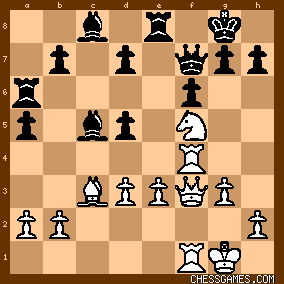
click for larger view
With this "wild" continuation possible:
23. g4 Rf8 24. Qg3 b5 25. g5 b4 26. gxf6 g5!? 27. Qxg5 Rg8 28. Qg7+ 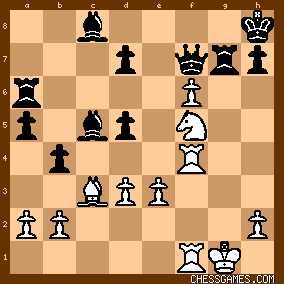
click for larger view Rxg7+ 29. fxg7+ Kg8 (with sufficient compensation for the pawn: 30. Nh6+ Rxh6 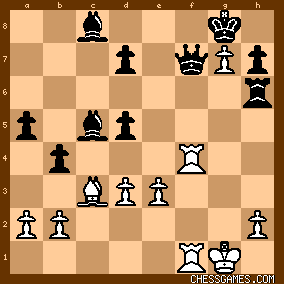
click for larger view 31.Rxf7 bxc3 32. Rf8+ Kxg7 33. R1f7+ Kg6 with sufficient compensation for the pawn.

click for larger view |
|
| Sep-20-09 | | Albertan: LifeMasterAJ, Fritz is right, the move 26.Qh5! leads to a forced checkmate position according to Deep Rybka 3!: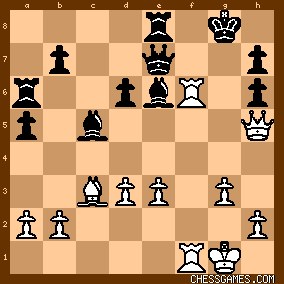
click for larger view26. Qh5!
If (a)26... Bd4 then: 27. Bxd4 Bf7 28. Rxf7 Qxe3+ 29. Bxe3 d5 30. Qf5 Rg6
31. Rf8+ Kg7 32. Qf7# checkmate!
If (b)26... Bxe3+ then: 27. Kh1 Bf7 28. Rxf7 Qe5 29. Bxe5 dxe5 30. Qf5 Rg6 31. Rf8+ Kg7 32.Qf7# checkmate! If (c) 26... Bf7 then 27. Qg4+ Kf8 28. Rxf7+ Qxf7 29. Qg7+ Ke7 30. Rxf7+ Kd8 31. Rc7 Bxe3+ 32. Kg2 Re5 33. Qd7# checkmate! |
|
| Nov-02-10 | | sevenseaman: Never quarrel with a machine! To me 26. Qe4 still looks a superior move to 26. Qh6. |
|
 |
 |
|
< Earlier Kibitzing · PAGE 3 OF 3 ·
Later Kibitzing> |





